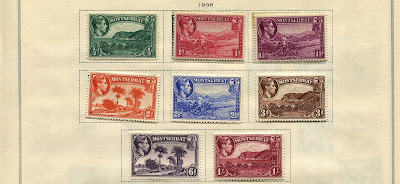Montserrat #s 75-77 -- green, red,
and orange brown
Bud's Observations
Rarely do stamp designs feature ghost towns. Even more
rarely does a thriving city illustrated on a stamp, in subsequent years, slip
into ghostdom.
Plymouth, Montserrat,
provides the exception. Spry and bustling when in the 1932 series came out (see
above), it was buried alive in 1995 and 1997 by a series of pyroclastic lava
flows from a volcano that had lain dormant for 300 years. You can see the sleeping
volcano, Chances Peak, on the stamps hovering over Plymouth.
Note Clock Tower (partially obscured by cancel)
#76,red, close-up 2nd example
Note War Memorial Clock Tower
Magnification shows some of Plymouth’s landmarks. In
the center is the War Memorial clock tower flanked by government buildings (partially obscured by cancel in the 1st example). Plymouth
was Monserrat’s capital and sole port of entry. It still is the government’s
official location, although no one lives or works there -- the world’s only
phantom capital. Fire and ash rendered Plymouth uninhabitable. Thankfully, all
residents evacuated safely then resettled in the northern part of the island or
elsewhere in the United Kingdom.

Plymouth and Chances Peak during an
eruption, from perspective similar to the 1932 series
Copyright © 2020 BBC
Plymouth’s War Memorial clock tower
before and after devastation, a postcard
Phantom philately -- collecting stamps cancelled in
ghost towns -- has a specialized following. They look for cancels from the
likes of Sixteen, Montana and Thistle, Utah, or from towns with ghostly names
such as Gnaw Bone, Indiana and Dead Woman Crossing, Oklahoma. In my locale, a
large “haunting” of philatelists collect cancels from dead post offices (“haunting”
is the collective noun for ghosts). Plymouth cancels struck during the eruptions
should command high prices, if there are such, for the post office is now
certainly dead.
Monserrat’s stamps remind me of another spooky matter
-- a pernicious myth circulating on the internet about atrocities supposedly
perpetrated against Monserrat’s early Irish immigrants. Yes, many of them were
indentured servants. But allegations that equate their circumstances to horrors
endured by African slaves are false, deceitful, and lacking in evidence,
according to knowledgeable historians. Montserrat’s 1903 series (#s 12 thru 20)
appropriately honors the island’s Irish heritage -- Erin, the female
personification of Ireland holding a harp, clinging to a cross, and looking
rather prosperous. The image was soon adopted as Monserrat’s coat of arms
(1909).
Scott #12, green
I find the false aggrandizement
of white indentured servants’ suffering disturbing, in a chilling sort of way,
because some of my own ancestors were indentured servants. One of them married
his master’s daughter -- a practice forbidden to African slaves. Although some
indentured whites were ill-treated, reparations were commonly available once
their servitude was completed. Not so for chattel slaves. For them, suffering
was perpetual and hereditary.
Census: 43 in BB
spaces, 19 on supplement page.
Note: the BBC pic (above) is copyright, and is used here for educational purposes.
Jim's Observations
Montserrat (10 miles by 7 miles) was named by Christopher Columbus in November, 1893, after the Monastery of Montserrat in (now) Spain.
The English, though, had control of the island by 1632, and Montserrat became known as "The Emerald Isle of the Caribbean": partially for its lush greenery, but more because the Irish were transported there as slaves, servants, and prisoners.
Page 1
1a
1b
1c
1d
Page 2
2a
Supplements
Page 1
Comments appreciated!














No comments:
Post a Comment